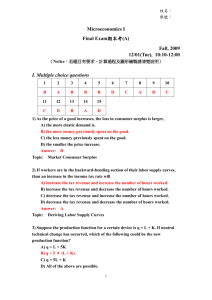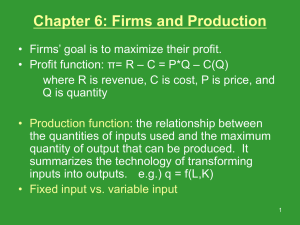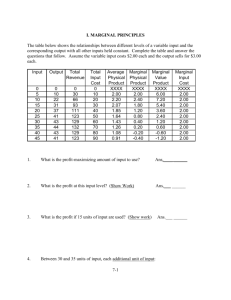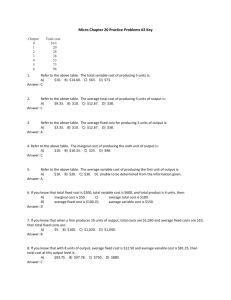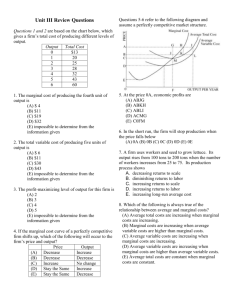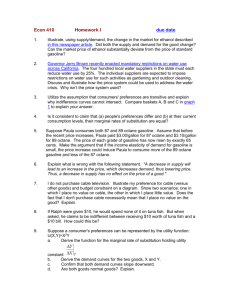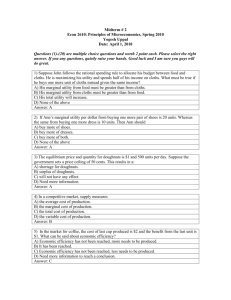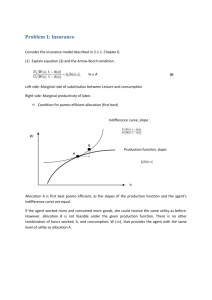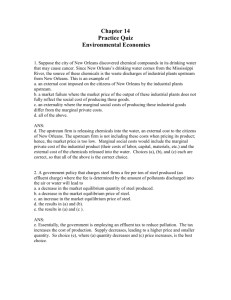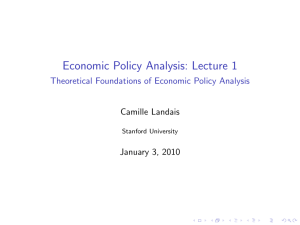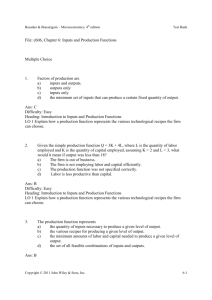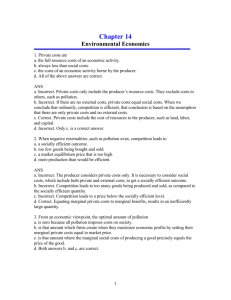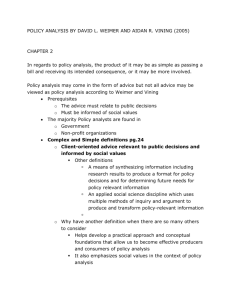Microeconomics I
advertisement
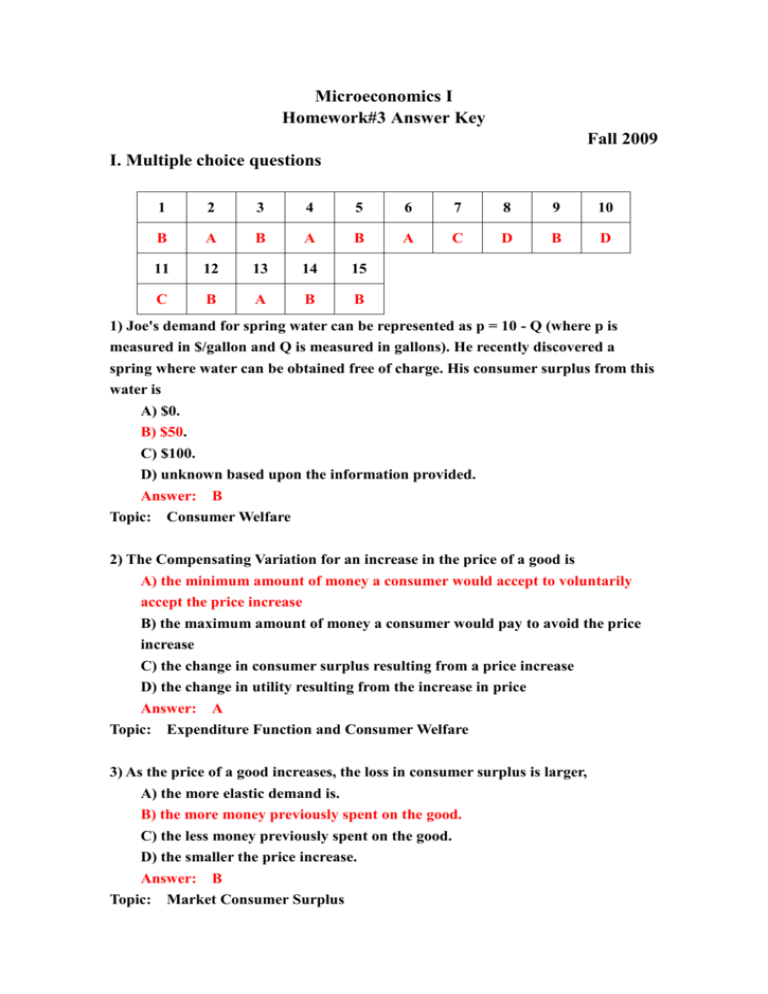
Microeconomics I Homework#3 Answer Key Fall 2009 I. Multiple choice questions 1 2 3 4 5 6 7 8 9 10 B A B A B A C D B D 11 12 13 14 15 C B A B B 1) Joe's demand for spring water can be represented as p = 10 - Q (where p is measured in $/gallon and Q is measured in gallons). He recently discovered a spring where water can be obtained free of charge. His consumer surplus from this water is A) $0. B) $50. C) $100. D) unknown based upon the information provided. Answer: B Topic: Consumer Welfare 2) The Compensating Variation for an increase in the price of a good is A) the minimum amount of money a consumer would accept to voluntarily accept the price increase B) the maximum amount of money a consumer would pay to avoid the price increase C) the change in consumer surplus resulting from a price increase D) the change in utility resulting from the increase in price Answer: A Topic: Expenditure Function and Consumer Welfare 3) As the price of a good increases, the loss in consumer surplus is larger, A) the more elastic demand is. B) the more money previously spent on the good. C) the less money previously spent on the good. D) the smaller the price increase. Answer: B Topic: Market Consumer Surplus 4) The Equivalent Variation resulting from a quota is best defined as A) The amount a consumer would pay to have the quota removed B) The amount the consumer would need to voluntarily accept the quota C) The amount a consumer would pay for the quantity specified by the quota D) The loss in utility resulting from the quota Answer: A Topic: Effects of Government Policies on Consumer Welfare 5) If a person supplies fewer hours of labor in response to a wage increase, then A) the substitution effect is greater than the income effect. B) the income effect is greater than the substitution effect. C) the income effect equals the substitution effect. D) the person is not maximizing utility. Answer: B Topic: Deriving Labor Supply Curves 6) If workers are in the backward-bending section of their labor supply curves, than an increase in the income tax rate will A) increase the tax revenue and increase the number of hours worked. B) increase the tax revenue and decrease the number of hours worked. C) decrease the tax revenue and increase the number of hours worked. D) decrease the tax revenue and decrease the number of hours worked. Answer: A Topic: Deriving Labor Supply Curves 7) Limited liability is a benefit to A) sole proprietorships. B) partnerships. C) corporations. D) All of the above. Answer: C Topic: The Ownership and Management of Firms 8) With respect to production, the short run is best defined as a time period A) lasting about six months. B) lasting about two years. C) in which all inputs are fixed. D) in which at least one input is fixed. Answer: D Topic: Production 9) Average productivity will fall as long as A) marginal productivity is falling. B) it exceeds marginal productivity. C) it is less than marginal productivity. D) the number of workers is increasing. Answer: B Topic: Short-Run Production: One Variable and One Fixed Input 10) Suppose the production of paved roadways can be represented as q L0.5 K 0.5 . Which of the following statements is (are) TRUE? A) Labor is subject to diminishing marginal productivity in the short run. B) Labor and capital are imperfect substitutes. C) The isoquants for paved roadways are convex. D) All of the above. Answer: D Topic: Long-Run Production: Two Variable Inputs 11) With capital on the vertical axis and labor on the horizontal axis, vertical isoquants imply that A) capital and labor are perfect substitutes. B) capital and labor must be used together in a certain proportion. C) capital is not productive. D) labor is not productive. Answer: C Topic: Long-Run Production: Two Variable Inputs 12) Let the production function be q ALa K b . Returns to scale are equal to A) a * b B) a b C) La K b D) A * L Answer: B Topic: Returns to Scale 13) The above figure shows the isoquants for producing steel. When producing less than 10,000 tons there are A) increasing returns to scale. B) decreasing returns to scale. C) constant returns to scale. D) diseconomies of scale. Answer: A Topic: Returns to Scale 14) The above figure shows the isoquants for producing steel. Constant returns to scale are A) present when producing less than 10,000 tons. B) present when producing between 10,000 and 20,000 tons. C) present when producing more than 20,000 tons. D) never present. Answer: B Topic: Returns to Scale 15) Which situation is most likely to exhibit diminishing marginal returns to labor? A) a factory that obtains a new machine for every new worker hired B) a factory that hires more workers and never increases the amount of machinery C) a factory that increases the amount of machinery and holds the number of worker constant D) None of these situations will result in diminishing marginal returns to labor Answer: B Topic: Short-Run Production: One Variable and One Fixed Input II. Problem 1)(個體經濟學 蔡攀龍、張寶塔 例 5.3 p.220) A’s Utility function is U(x,y)=xy2. And the prices of x and y are px=0.5 and py=1. A’s income is $90. If the price of x increases to px=1, what are A’s compensating variation (CV) and equivalent variation (EV)? Ans: See the book of 個體經濟學 蔡攀龍、張寶塔 例 5.3 p.220. 2)(ch5 solved problem 5.3, p.155) If Sofia has a Cobb-Douglas utility function, U=(wH)(1-a)(24-H)a, what is her labor supply function, if a = (7/12)? Ans: Similar with textbook of ch5 solved problem 5.3, p.155. ans is 10 hours. 3)(ch6 Q2) Each extra worker produces an extra unit of output, up to six workers. After six, no additional output is produced. Draw the total product of labor, average product of labor, and marginal product of labor curves. Ans: 2. See Figure 6.3. After the sixth unit, marginal product of labor falls to zero. Total product remains at 6 units, and average product of labor falls after the sixth unit. Figure 6.3 4)(ch6 Q26) Under what conditions do the following production functions exhibit decreasing, constant, or increasing returns to scale? a. q=L+K, a linear production function. b. q=ALaKb, a general Cobb-Douglas production function. c. q=L+ LaKb +K. ρ ρ ρ d. Q=(aL +bK )d/ , a general CES production function. Ans: 26. a. This production always displays constant return to scale. b. The Cobb-Douglas production function has decreasing, constant, or increasing returns to scale as is less than, equal to, or greater than 1. c. This production function has decreasing, constant, or increasing returns to scale as is less than, equal to, or greater than 1. d. The CES production function has decreasing, constant, or increasing returns to scale as d is less than, equal to, or greater than 1.


